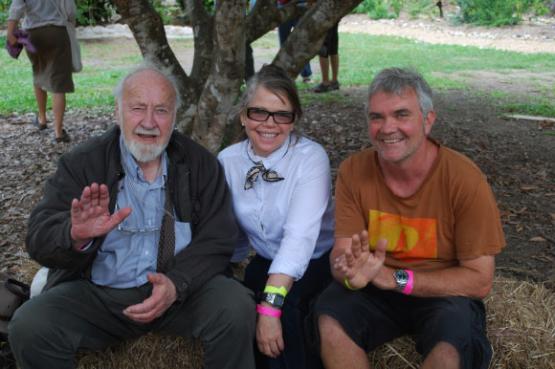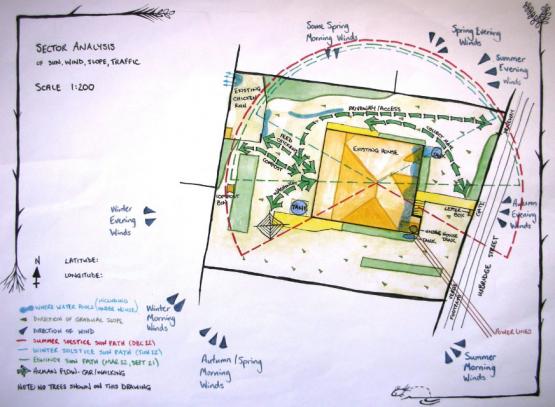
Permaculture Design
7 min read
By Mark Garrett
Design is fundamental to permaculture as a lot of thought has to go into trying to figure out what’s what in the tangled webs that are ecosystems. If I do X, what will it affect? If I need Y, then what should I be putting in place?
Permaculture design looks at the interrelationship of elements we require within our living environments and their surroundings. How is each element going to be nourished, supported, maintained as best as it can be, to flourish and create abundance for all things living in this environment? And since to be ‘permanent’ the design needs to be truly sustainable, how do I do this not just for now but for future generations?
This thought process can be applied to any context – both new and old. I have used it just as effectively to create brand new properties from scratch just as I have to retrofit existing homes, farms, island resorts, schools and inner city apartments, across the world in all sorts of climate zones.
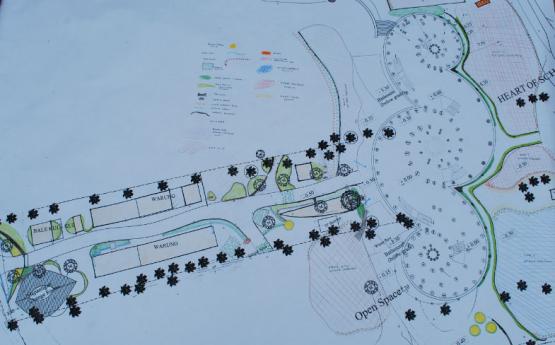
Designing, the permaculture way, gets you thinking about what you have readily available to you and how you need to support these elements so that they are part of a productive system that is non polluting and does not exploit our environment.
Applying the 8 principles of permaculture design guides you in creating a sustainable system of low inputs for higher yields and financial long-term security.
There is a saying “100 hours research for one hour of work” and it’s unbelievable how true this is. I learnt it the hard way by doing things off the bat without taking time to research. The result was that I then had to do it all over again. So please research, it does make life easier and permaculture is all about making life easier for yourself, not harder. As we permaculturists like to say, “If it isn’t fun, it’s not permaculture”.
When sitting down to design your permaculture system remember there is not only one permaculture, so your design will be unique to you as your individual requirements will be different from others, and your land and resources will determine how your system will develop.
First, create a detailed brief of what you want to achieve (your goals). Do you want to save water, energy, money, improve soil health or control pests? (The list is limitless).
Then think, what resources are available to you, in terms of finances, labour, skills and time?
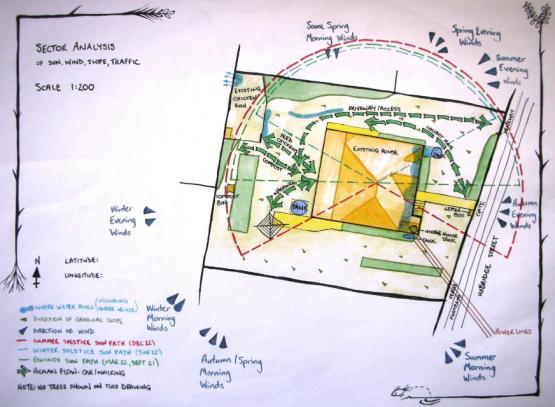
After you have completed your brief, the next step is to undertake a “Sector Analysis” this is when you identify all of the different elements – manmade as well as natural – that will impact your design. For example, you will need to consider any physical manmade structures that exist onsite (do you have a house? A barn? Chicken coops? Are there any roads or paths or walls on site?…), as well as the natural resources that are there too (animals, plants, weather conditions – and don’t forget to factor yourself into the equation!).
In terms of nature’s wonders that will impact upon your site, try and think about specifics, including rain, wind, sun, snow, frost and site orientation (this last refers to the degree of the slope of your land and the direction it faces). You will need to consider the frequency, direction, amounts and force of these weather conditions, as this can radically affect your design.
Once you have collected together all this information, you can then start to look at how you can harness these energies to benefit your overall design.
When thinking about the placement of your various design elements (i.e. what should go where), think about how often you will need to use them and how often you need to care for them. Think of your design as being carved up into 5 zones – where your home (i.e. the place you spend most of your time) is directly in the centre and the zones then feed out from this point. Zone 1, then, might be where you would place the kitchen garden, as it would be as close to the kitchen as possible since you will going here up to 3 times a day to harvest for meals. Fruit trees, on the other hand, would be placed in zone 2 or 3 as you only need to pick fruit a few times a week and caring for fruit trees is less intensive than caring for vegetables. Remember, you are trying to conserve energy and time by placing elements in their correct zone.
We also need to look at the relationship between elements in each zone and what they need, in terms of food, water and pest control. By placing the chicken house in zone 2, for example, (which borders zones 1 and 3) it will then mean that we have supply of manure for gardens that need on-going maintenance, as well as a mulching and pest management system at hand for the gardens in all 3 zones. The chicken house itself is also a water source thanks to rain collection off the roof that is diverted into holding tanks and ponds for the benefit of all. In other words, all the elements need to be linked to benefit each other without losing any resource produced or gathered onsite. (This is part of the closed loop nutrient cycle that I will be exploring in my last blog which will be posted on 17 April 2013).
To better understand the placement and interrelationship of elements, here’s a real example: my home. I knew that I wanted to live somewhere that was as free as possible of synthetic chemicals. I also knew that I did not want to spend all my time and money building and maintaining a house. I wanted something that was easy to manage and created abundance, even if left to its own devices. In other words, this was my brief.
The 2-acre piece of land I found for my project consisted of an ex cow paddock, whose soil was compacted and barren. Although it might not sound like the ideal plot of land, I did exactly as mentioned above. I identified my site and design elements and thought about their placement and interrelatedness. Today, thanks to applying permaculture principles my home is self-sustaining in vegetables, herbs, spices, tropical fruits and native Australian bush foods plus it has an abundant water supply, all collected on site. The land was reborn.
What’s more, my house utility bills are non-existent now, thanks to the permaculture design that was implemented. I use the sun as heating by storing the heat from the day in a stone wall and concrete floor. Windows positioned correctly also allow the sun to light up the house longer in winter. Selectively placing trees also means that the house is shaded and cooled in summer. The trees are then cut in the colder months, allowing the winter sun to warm the house, and creating firewood that is used for heating, cooking and mulching to feed the soil, which grows the tree again in spring, starting up the cycle for the next year.
When designing the house itself, I focused on low maintenance building materials so that once these were in place there was no need to do any thing further with them. Materials selected included coated iron cladding, concrete polished floors, glass doors and windows with river stone walls. Today, all I do is brush away the cobwebs now and again, and occasionally clean the windows. I have had the house now for 8 years and never had to paint or replace anything except a few plumbing fixtures and fittings.
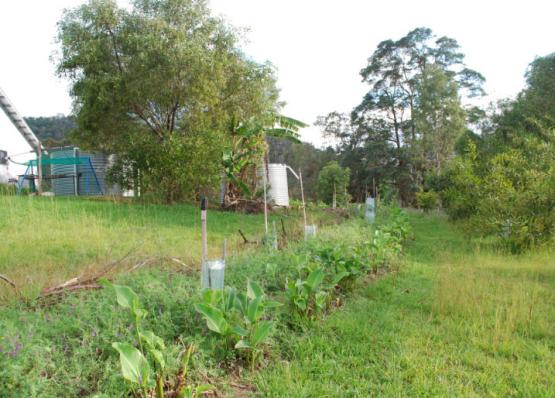
The thing to remember is that nature works in a closed loop nutrient cycle, such that all waste generated by one part of the cycle, is a nutrient supply for another. Consequently, we can design closed loop waste management systems that keep all of this recyclable wealth on our properties, creating composts, liquid fertilizers, organic pest management solutions, energy generation and much more. The tools and solutions for creating your closed loops are out there and available to you. It just takes a little thought and lots of observation and research. As such, it is certainly best to start out designing small projects and grow your designs organically as you gain experience and knowledge from your observations and practice.
Permaculture will change the way you look at life and give you a structure to solve problems others seem to have given up on. Through observing nature and a little research you too can make a positive impact on the environment. You don’t need to have a farm or even a backyard; it is not all about growing vegetables it is also about not polluting or exploiting the world we live in. It just takes a little thought – care for the earth, care for the people and create abundance for us all to share.
If you have any questions, post your comments below and I will get back to you. Alternatively you can get hold of me on Twitter (@MGpermaculture) or by email.
A little practice
The example above of my house design addresses Bill M’s Permaculture Design principles, mentioned in my blog post “What is Permaculture”. Can you identify which principles I applied from the list below?
Permaculture Design principles:
- Relative location of elements placed to assist each other
- Each element performs many functions at least 3
- Efficient energy planning (zones and sectors)
- Emphasis on use of biological resources over fossil fuels
- Energy recycling on site (fuel and human)
- Using and accelerating natural plant succession to establish favourable sites and soils
- Polyculture and diversity to benefit species for productive, interactive systems
- Use of edge and natural patterns of Nature for best effect

